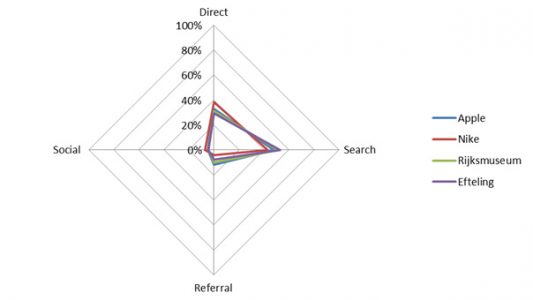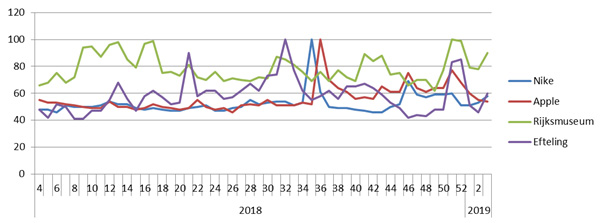Influencer marketing: 3 easy steps to distinguish influencers that are worth your marketing budget
Out of curiosity about the latest trends in online marketing, I generally like getting a better understanding of what the excitement is all about. And what better way to understand things than by quantifying them. That’s how I dove into the latest hype in online marketing, called ‘influencer marketing’. And found 3 steps to distinguish influencers that are worth your marketing budget. But I’m getting ahead of myself, let’s start from the beginning.
What is influencer marketing?
In principle a clever marketing technique. It makes a lot of sense that there are specific individuals that can rightfully be called specialists, experts or even celebrities. And for this reason get more attention and more credibility. And by associating with these as a brand, you will indeed attract positive attention for your products.
So in a nutshell influencer marketing is: the ‘who-is-an-authority-in-my-industry-and-how-can-I-get-that-person-to-promote-my-product’ principle.
- Benefit: relevant new visitors
- Potential to instant conversion is high (equivalent of qualified leads)
Not the same as content marketing, where the emphasis lies on offering interesting information (infographics, whitepapers, top 10 lists etc.). And generating backlinks through that information, which gets you referrals and in turn can improve your ranking in Google. The ‘how-do-I-stuff-a-platform-with-as-much-info-as-possible-so-that-I-have-to-be-found’ principle.
- Benefit: loads of new visitors
- Potential to instant conversion significantly lower (equivalent of cold leads)
But how many influencers are there really and is it really specialists, experts and celebrities that join influencer marketing networks these days?
To answer that question, let’s first determine how to recognize a domain that belongs to an influencer or an influential editorial board.
How to recognize an influencer?
So here I’m not looking for an influencer with only a presence on social media. Those are quite easy to spot. But those with their own platform outside of social media. Their own websites or blogs.
Let’s see if we can figure that out by answering a couple of questions that you can just ask yourself.
- Have you bookmarked the URL of the website of someone that influences you or maybe even know it by heart?
- Then you can expect that website to have a decent share of direct traffic.
- Do you follow posts by someone that influences you and click through to their site?
- Then it’s also reasonable to expect social media to be a relevant traffic source.
- Do you like, share or comment on posts by someone who influences you?
- Then presumable there’s noticeable engagement.
The above seem to me like reasonable assumptions. So then it should be possible to make a comparison. If we’d have the data available. Or at least an estimate.
Benchmark data for influencers
An estimate of the traffic of other’s websites is always tricky. No matter which tool you use, Similarweb, Alexa or Ahrefs, you will always find that the numbers deviate from reality.
Luckily, if you’re looking to compare multiple websites you’re pretty much fine as long as you consistently use the same tool. That way, whatever deviation is embedded in the estimate, is the same for all sites you compare. For the below I’ve used Similarweb (according to Screaming Frog the most reliable a couple of years ago).
As a benchmark I’ll assume that an influencer shows characteristics similar to those of a real brand. Just applied to an individual. So for comparison I’ll start with data about real brands. Below the data for various renowned brands. Both international and Dutch.
Comparison well-known and influential brands

What you’ll notice is that each of the brands indeed confirms the questions about traffic posed earlier. While half of the traffic comes from search, a significant part comes from direct traffic. Also referrals and social traffic play an important role.
So is this the same picture that the data about famous influencers shows? Let’s have a look at the (websites of) a number of well-known and influential individuals (again both international and Dutch).
Comparison well-known and influential individuals

The main difference between brands and individuals seems to be that for websites by individuals a shift is visible from referral traffic to social traffic. Which makes sense since they directly engage with their audience on social media, while for many large companies this is exactly what they’re struggling with.
For the rest the picture looks remarkably similar. The relatively high percentage of traffic from search for Nienke Plas seems to be explainable by the searches for her popular merchandise (recently).
Now this makes me curious about the picture that we get when looking at some of the influencers that are registered with influencer networks like Linkpizza.com, Hulc.nl and Bloggerlijst.nl. And then I’m not talking about the large media outlets like Hearst (whose sites are just brands), but about the lesser known registrants to these kinds of networks that somehow seem to attract significant traffic.
Comparison of a number of influencers from influencer networks

Now without wanting to come across too cynical, these numbers really do show a different picture. If I hadn’t known what the URLs were, I would have simply expected (with on average 90% of traffic from search) that this wasn’t about influencers but simply about content platforms.
Neither the URL recognition, nor referrals, nor traffic from social media suggest that there’s any relevant influencing going on. And you could say that it’s because they’re blogs. Sure. But it’s not as if influential blogs don’t show a picture similar to brands.
Comparison influential blogs

With the above blogs we’re talking about audiences of many thousands if not millions of followers, and as you can see a big chunk of those know how to find them directly. Complemented by referral and social traffic.
How about their influence on social media then?
An alternative explanation could be that it’s not the platform itself where they influence their followers. Maybe it’s all going on at Twitter, Facebook or if not those, then surely Instagram?
To determine whether this is the case, I’ve retrieved the average engagement with the last five posts for all of the above platforms. With engagement simply defined as the sum of all interactions, whether it’s likes, comments or shares.
That exercise gets us to the below. Please note: the y axis has a logarithmic scale as it’s not realistic to expect a local influencer to have the same volume as a multinational.
Comparison influencers on social media

With a handful of likes and re-tweets here and there, this suggests that even on social media there is absolutely no scenario of a crowd getting influenced. Not sure what the exact definition is, but 10 hardly seems like a crowd.
Why do influencer campaigns if there’s no influencing going on?
The only reason I can think of why these kinds of platforms are included in an influencer network is then really simple. Backlinks. Paid backlinks that is.
Wrapped in content that, as far as I can tell, is neither unique nor of any added value. So just a poor man’s version of content marketing. Through a network of blogs.
Or as Google describes it: Large-scale article marketing or guest posting campaigns with keyword-rich anchor text links.
And if you think that it surely can’t be just that, please realize that the networks quite blatantly refer to the costs for placing a follow link. And even include the exact anchor texts of links in campaign templates. To be honest, it really doesn’t get more obvious.
What to look out for with influencer campaigns
Perhaps it’s redundant to say then, but as a brand looking to do influencer marketing I’d be careful about the platforms that I’d involve. First of all, because buying backlinks (whether or not you stuff them in content) sooner or later puts you at risk of being penalized by Google. And equally important in the short run, the actual influencer effect of increased conversion can really only be achieved with actual influencers.
So be sure to have a look at tools like Similarweb first and check the social media profiles for the platforms you’re planning to work with. As explained, the real influencers are fairly easy to spot.
Bonus tip on how to recognize influencers
Influencers have another characteristic in common, namely name recognition. Whether it’s world-wide or locally. And that means that there has to be a certain level of search volume for the name of the influencer or influencing platform.
To determine whether that’s true for the influencer that you’re planning on collaborating with, have a look at Google Trends. This gives an indexed volume of search queries (not absolute) over time, which should show even a small query volume.
Below is the result for the brands and influencers evaluated so far.
Search volume for brand names

Search volume for influencers

Search volume for a number of influencers on influencer networks

As you can see, once again it’s confirmed that influencing people requires more than just a blog with a lot of content.
So is influencer marketing really as big as it seems or just a clever way for influencer marketing networks to offer their services? To be honest I think Forbes says it right with:
Customers: The Actual Influencers Brands Should Focus On.
Experiences or insights into influencer marketing worth sharing? Looking forward to reading them in the comments.
